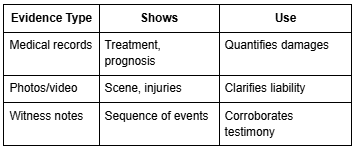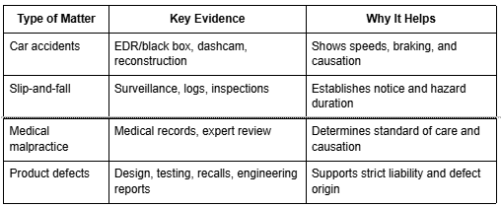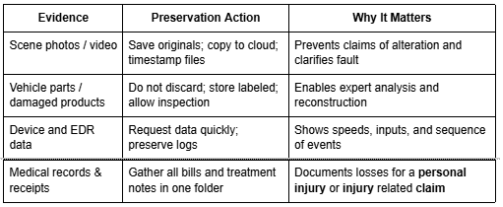Few disputes reach a jury. Most resolve at the settlement table because clear proof makes liability and compensation easier to assess.
Evidence links each step: duty, the expected care, the breach, causation, and the resulting damages. Good records turn scattered facts into a coherent story a judge or insurer can accept.
Photos, medical notes, witness statements, police reports, and expert opinions all matter. Timely gathering of these items helps the victim and their attorney control the narrative and cut disputes over what happened.
In California, strict time limits apply, and comparative negligence can reduce awards by the plaintiff’s share of fault. Many attorneys work on contingency, so thorough documentation often raises the amount offered and shortens the time to resolution.
Start an organized file right away. Preserving receipts, device data, and scene images gives the best chance to show both economic loss and non‑economic pain suffering when it matters most.
Why Evidence Is the Backbone of a Personal Injury Lawsuit
Hard records and expert analysis let decision makers trace fault from act to harm. Proving negligence requires showing a duty of care, a breach of that duty, causation, and actual damages. Each element needs concrete proof so a judge or insurer can assess liability.
Linking evidence to duty, breach, causation, and damages
Eyewitness reports, medical notes, and accident reports map what the defendant did and whether a duty existed. Photos and black box data help tie the breach to the injured party’s losses.
How strong documentation influences settlement vs. trial
Well‑organized files raise negotiating leverage. Insurers use the same legal tests, so clear records often increase the amount offered and shorten resolution time.
- Objective items — police reports, video, expert analysis — support each legal element.
- Treatment records and bills quantify economic losses and non‑economic harm.
- Technical data, like skid marks, can narrow disputes over fault.

Victims should share all materials promptly with counsel. A clear timeline helps the court and raises the chance of a fair resolution without unnecessary delay.
Personal Injury Claim
A claim for compensation begins when someone seeks to hold an at‑fault party financially responsible for losses from carelessness or worse. This civil demand can arise from negligence, strict liability, or intentional conduct.
Typical phases include consultation, investigation, the claims process, and possible lawsuit filing. Discovery and negotiation follow, and trial remains an option when settlement stalls.
Evidence guides strategy from day one. It shapes which experts to hire and how to present damages, whether economic or non‑economic.
- Damages cover bills, lost wages, and pain or loss of enjoyment.
- Different types—auto, premises, product, malpractice—need tailored proof and experts.
- Early medical care, consistent treatment, and clear records strengthen an injury case.

Open, timely communication with a personal injury attorney or injury attorney helps ensure symptoms and daily limits are recorded. That collaboration improves the odds of full recovery for documented damages and fair resolution under the law.
Choosing the right personal injury lawyer Santa Ana could be the difference between a quick settlement and a long legal battle.
What Counts as Evidence in Injury Cases
What people wrote, photographed, or logged often decides who is held liable and how much they pay. Evidence spans medical files, scene media, witness notes, and insurance records. Each item helps link an act to the resulting damages under the law.
Medical records and documentation
Provider notes, itemized bills, diagnostic images, and pain logs show the scope of injuries and treatment. Consistent treatment records and EOBs also reveal costs and prognosis.
Scene reports, photos, and video
Accident reports, dashcam clips, and surveillance from car accidents or a slip and fall capture conditions and mechanisms. Photos of bruising or assistive devices illustrate non‑economic harm.
Witness accounts and contemporaneous notes
Third‑party statements and daily symptom logs boost credibility. Workplace reports and early notes are powerful when timelines are questioned.
- Insurance correspondence and policy declarations map coverage and possible liens.
- Chain‑of‑custody for devices and physical exhibits protects authenticity.
- In medical malpractice, chart audits and expert opinions define the standard of care.

Tip: Save every bill, receipt, and note. Small items often swing negotiations and trial outcomes in favor of the injured party.
Proving Negligence: Duty of Care, Breach, Causation, and Harm
Clear proof links what happened at the scene to the legal elements courts require to assign fault. To succeed, a plaintiff must show a duty existed, that the defendant breached it, that the breach caused harm, and that measurable damages flowed from the event.
Establishing who owed a duty
Duty depends on the relationship and the setting. Drivers owe other road users safe conduct. Property owners owe lawful visitors basic safety. Employers and professionals face higher obligations in many situations.
Showing a breach with objective facts
Objective evidence — safety code violations, speed data, inspection records, or missing warnings — proves conduct fell below expected care. Scene measurements, photos, and reports make the breach hard to deny.
Linking the breach to harm and damages
Medical opinions and treatment timelines connect the breach to the injury. Bills, wage records, and functional reports quantify damages. A clear sequence of events helps exclude other causes.
- Witness testimony and the plaintiff’s own account humanize the timeline.
- Experts translate technical data into clear conclusions about liability and losses.
- Preserved records can rebut defenses, such as prior knowledge of a hazard.

Practical tip: Keep a short symptom log and copies of bills. Small, timely records strengthen causation and make damages easier to prove.
Evidence by Case Type: From Car Accidents to Medical Malpractice
Each incident type brings a distinct set of documents and experts that turn facts into legal proof. This section explains the common types of proof used across frequent matters and why tailored evidence matters to show liability and damages.
Motor vehicle collisions
Black box or EDR data, dashcam footage, and scene reconstruction reports clarify speed, braking, and impact angle. Photographs and measurements lock in vehicle positions and roadway conditions.
Slip-and-fall incidents
Surveillance video, incident logs, cleaning schedules, and inspection records establish notice and hazard duration. Witness statements and maintenance invoices help show whether the defendant knew or should have known of the danger.
Medical malpractice
Medical records, independent chart reviews, and expert testimony probe deviations from the standard of care. Experts connect negligent acts to resulting harms and estimate compensation for ongoing treatment.
Product defects
Design files, test reports, recall notices, and engineering analyses support strict liability claims. Physical samples, warranty records, and manufacturing documents help trace defects to a specific type or batch.
Practical note: Plaintiffs and attorneys align each piece of evidence to the law that governs the dispute. Most matters settle once technical facts are clear, so preserving vehicles, footwear, or devices quickly is critical.

Preserving Evidence Immediately After an Accident
Securing documents, photos, and device data right away prevents loss and narrows fights over what really happened.
Spoliation risks and preservation letters
Evidence can vanish fast. Vehicles get repaired, phones are reset, and surveillance clips are overwritten in a short time.
Attorneys often send preservation letters to each relevant party and to insurers. Those notices demand that records, devices, and physical items be kept safe. That step reduces disputes in later cases.
Chain of custody for physical and digital items
Maintaining a clear chain of custody keeps evidence admissible. Note who handled an item, when it moved, and where it is stored.
Label damaged products, vehicle parts, or devices with dates and brief notes. Back up photos and videos to multiple locations to protect digital files tied to an accident.
- Make copies of police and incident reports immediately.
- Back up phone photos and dashcam clips to cloud and external drives.
- Store physical items in dry, labeled containers and note who has them.
- Record symptoms and treatment from day one to document any lasting injuries.

Quick tip: Centralize receipts, messages, and medical notes in one folder. Early preservation often shortens disputes and helps insurers evaluate liability and damages sooner in a personal injury matter.
Conclusion
A focused evidence plan helps a claimant preserve value and avoid common pitfalls that reduce recovery.
Prompt medical care, steady treatment, and an organized file speed resolution and support full compensation. Careful records reduce disputes over fault and the final amount awarded.
Because comparative negligence can lower recoveries, detailed proof matters more. Most personal injury cases settle once liability and damages are clear.
Victims should consult a personal injury attorney or injury attorney early to protect deadlines, coordinate experts, and shape strategy.
Start a simple checklist today: reports, photos, bills, and notes. That small step helps preserve value and keeps the claim on track.